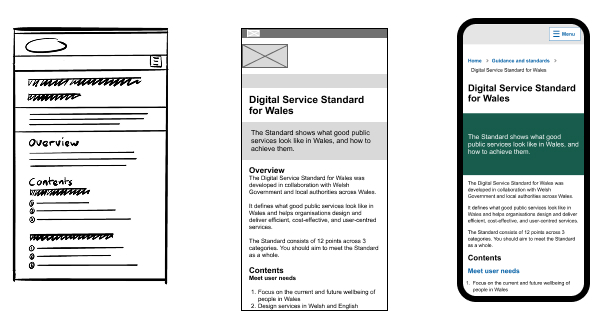Overview
Before building a service, prototype it.
Prototypes help you test ideas quickly, get feedback from users and avoid costly mistakes. Prototyping is useful when:
- requirements are not clear or may change
- you’re testing a new idea or concept
A prototype does not need to be perfect. It just needs to be good enough to learn from.
What a prototype is
A prototype is a rough version of something you want to test. It helps you:
- test your ideas with users
- identify problems early
- build shared understanding in your team
- get better feedback from stakeholders
Start small. It’s better to test a rough idea early than wait for something polished.
Prototypes can be simple or detailed, from sketches to interactive mock-ups. What matters is showing the concept to learn from it.
Depending on what you're testing, a prototype might be:
- a sketch, wireframe or simple click-through
- a paper form or printed letter
- a role-play or call script
- someone reading your content and saying what they’d do next
Prototypes don’t need to be perfect, they can be as simple as a sketch or as refined as a high-fidelity mockup.
Building a prototype
Start with a low-fidelity prototype to save time building something that does not meet user needs. You can prototype:
- a digital or physical product
- a service
- a specific interaction or journey
For example, you could:
- sketch a paper version of an app and test it with your team
- make a basic digital version and try it with users
- build a high-fidelity version with branding and refined content

Tools you can try
Digital products
You can try tools like:
- Figma, Sketch or Adobe XD
- PowerPoint, Keynote or Canva for simple click-throughs
- Squarespace, Wix, Wordpress or Marvel for browser-based tests
Paper-based products
This could include things like letters, reports, brochures and flyers.
You can prototype using:
- Word and Google Docs
- Canva or similar tools
- presentation software
Always print a paper prototype to see how it works in real life.
Services
You can prototype a service using:
- A call script or storyboard
- Physical models or photos
- Roleplay with colleagues or props
You can even use objects like toys or play-dough to model experiences.
Testing your prototype
Testing helps you understand if your idea works for users.
Learn about the importance of testing in user-centred design.
Depending on the prototype, you can:
- observe people using it
- ask them to think aloud
- note where they get stuck or confused
- ask open questions like “What do you think this is for?” or “What would you do next?”
- test bilingually
This helps you improve before investing time or money.
Learn more about researching your users and testing your service.